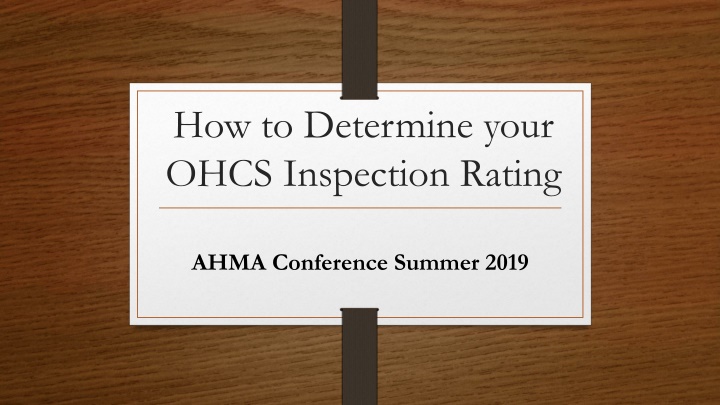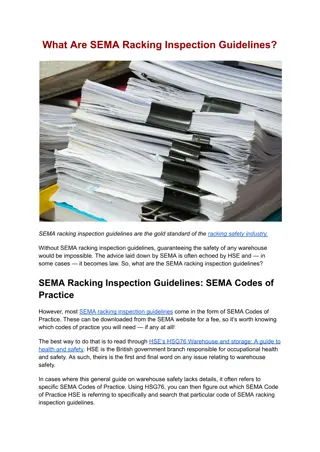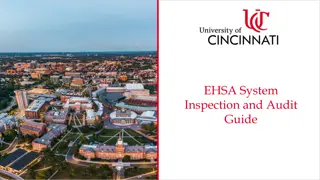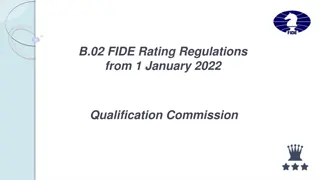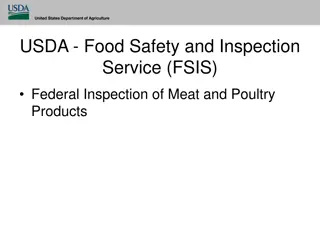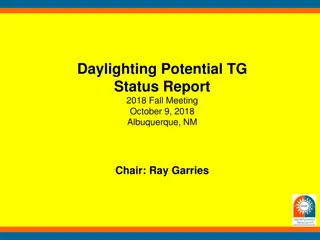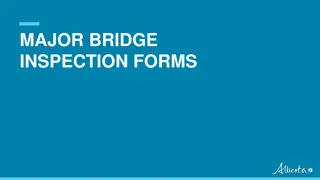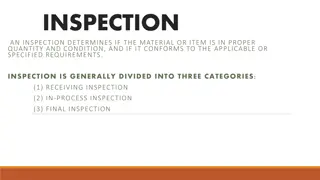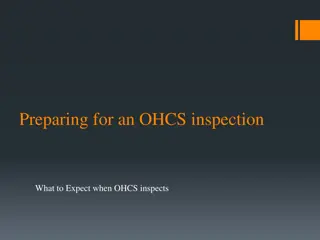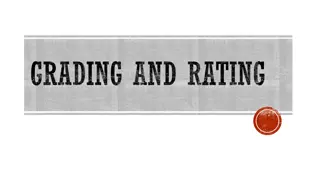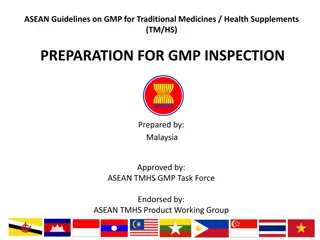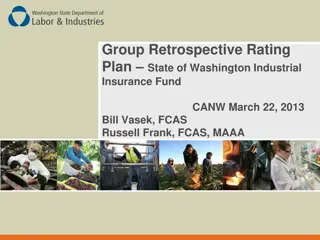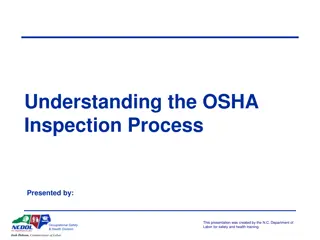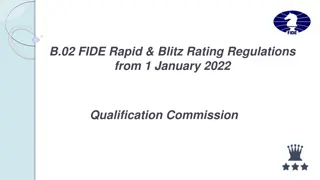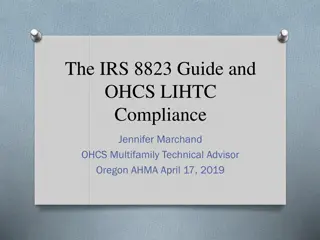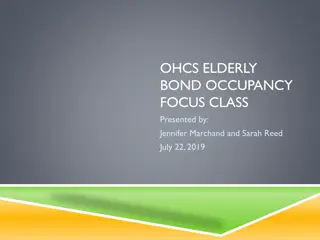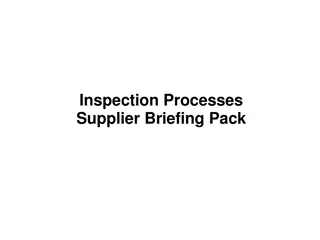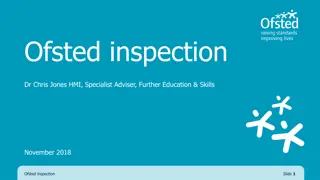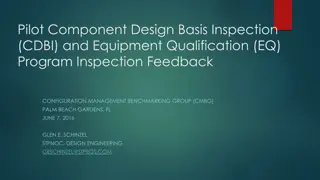OHCS Inspection Rating Process at AHMA Conference Summer 2019
Learn about the OHCS inspection rating process discussed at the AHMA Conference Summer 2019. The process includes different types of inspections, steps involved in the inspection process, common findings, tips to improve rating, consequences of non-compliance, and the new IRS requirements. Understand how OHCS evaluates responses, assigns ratings, and manages properties for compliance. Stay informed about recent changes in inspection regulations outlined by the IRS.
Uploaded on Sep 24, 2024 | 0 Views
Download Presentation

Please find below an Image/Link to download the presentation.
The content on the website is provided AS IS for your information and personal use only. It may not be sold, licensed, or shared on other websites without obtaining consent from the author.If you encounter any issues during the download, it is possible that the publisher has removed the file from their server.
You are allowed to download the files provided on this website for personal or commercial use, subject to the condition that they are used lawfully. All files are the property of their respective owners.
The content on the website is provided AS IS for your information and personal use only. It may not be sold, licensed, or shared on other websites without obtaining consent from the author.
E N D
Presentation Transcript
How to Determine your OHCS Inspection Rating AHMA Conference Summer 2019
Agenda General Overview OHCS Inspection Process Physical and Compliance Reviews File Inspections New IRS Regulatory Requirement OHCS Rating Criteria OHCS Rating Process Common Findings and Mishaps 2018/2019 What not to do Tips and Tricks to Improve Rating and Good Standing Consequences of Non-Compliance
Inspection Process Type(s) of Inspection: 1. OHCS Physical or Compliance Review File Inspection 2. OHCS Group Inspection (larger properties requiring on-site file review) 3. Federal Streamline Inspection 4. State Streamline Inspection 5. OHCS Sec 8 Mixed Funded Inspection
Inspection Process Inspection date is set and confirmation letter is sent Pre-inspection paperwork due to OHCS OHCS performs pre-inspection due diligence (desk work) Inspection occurs Report is sent by OHCS Response is due by Owner/Agent OHCS evaluates response, assigns rating and closes inspection
Inspection Process Final Behind the Scene at OHCS After the rating is assigned and the closing letter is sent to Owner/Agent Property is reviewed for risk and next inspection date is determined (GOAL should be every three years) Notifications of non-compliance are sent to the IRS or HUD as required Risk properties are reported to Asset Managers for follow up Issues are reported to Technical Advisor, Lead Workers and Upper Management
New IRS Requirement On March 1stOHCS sent out a memo regarding IRS final regulations which were announced by the IRS on February 26th. Significant changes to the inspection process are detailed in the regulation: Includes both physical and file inspection sampling for LIHTC first 15 Notification requirement from 30 to 15 days New sample sizing Both vacant and occupied low-income units in a low-income housing project are included in the population of units from which units are selected for inspection. Maintain all buildings rule
New IRS Requirement Continued Random unit selection guidance was clarified by the IRS to say: OHCS must select in a random manner the low-income units to be inspected and the units whose low-income certifications are to be reviewed. OHCS generally may not select the same low-income units of a low-income housing project for on-site inspections and low-income certification review, because doing so would usually give prohibited advance notice. OHCS may choose a different number of units for on-site inspections and for low-income certification review, provided that OHCS chooses at least the minimum number of low-income units in each case. OHCS must select the units for inspections or low-income certification review separately and in a random manner. OHCS may notify the owner of the low-income units for on-site inspection only on the day of inspection
New IRS Requirement Continued Discussion: What does the new requirement specifically mean for OHCS, Owners and Agents?
OHCS Rating Criteria Compliance Reviews (File Inspections) 1. Management Operations 2. Leasing and Occupancy Policy How property is maintained (generally and not specifically for example vacancy and turnover not specific unit maintenance) Preparation Materials (pre-inspection requests) Tenant Files Review Response
OHCS Rating Criteria Compliance Reviews (File Inspections) Continued Resident Resources Complaints Financial Communication Fair Housing
OHCS Rating Criteria Physical Inspections 1. Property Maintenance Operations How property is maintained (generally and not specifically for example vacancy and turnover not specific unit maintenance) Physical Inspection Prep and Materials Physical Inspection (actual physical condition of property including units etc.) Inspection Response Communication Fair Housing
Only Two Possible Ratings 1. Meets 2. Does not Meet Notes are usually indicated on closing letter indicating more information about the specific issue(s) that may have led to the rating decision
Common Findings Physical Damaged walls and doors Trimming of vegetation from exterior siding or roof of buildings Cleaning of gutters Moss on roofs Pressure Washing of siding or Parking areas Inoperable ground fault circuit interrupters (GFCIs) Inoperable smoke detectors Flammables stored in the oven Inadequate heater clearance Inoperable or failing range ventilation fans Damaged door frames
Common Findings Compliance Review Missing student verification forms Missing VAWA information Incorrect rent determinations for voucher holders Miscalculating rent when a unit was mixed with other funding sources Incomplete or Incorrect Monitoring Reports Vacancy and Turn Time Not following or updating AFHMP Tenant Selection Plan not specific to property Rents over approval Not fixing unit mix when tenant is over income Late or incomplete file verifications and documents
#1 Mistake Responding late to requests for pre-inspection information or inspection response and not requesting an extension Both Physical and File Compliance Audit Reviews
What not to do Do not forget to notice tenants for physical inspections Do not forget to train employees on inspection procedure Do not report all items as corrected if they are not corrected Do not submit late or incomplete pre-inspection or response information Do not forget to ask for an extension before the response or information is due Do not blame issues found on previous Staff, Management Company or Owners Do not blame issues found on lack of staffing
Tips and Tricks to Improve Rating Train employees or yourself on rating criteria and program funding requirements Make sure you have an updated Administrative Notebook on site Notice tenants for inspections Perform a pre-inspection of physical areas (ask someone else to look at your property as well) Have a second set of eyes review all files Make sure you are timely with submitting information requests and responses
# 1 Tip for Improving the Inspection Rating 1. Be honest 2. Explain situations 3. Ask for extensions 4. Take Responsibility 5. Explain plan for resolving issues Communication
Consequences of Non-Compliance File 8823 Form with IRS IRS Recapture or Audit Pay Back other funding loans or grants (may not be pro-rated) Stop and restart affordability clock with non-compliance Require replacement of Management Agent/Site Staff Disapprove Owner or Developer for future funding consideration Additional site visits, monitoring, and oversight
Consequences of Non-Compliance Continued Additional required reporting for desk audits (example-vacancy reporting) Reestablish annual certification requirement Involve all parties and ask for a work-out plan (this will bring everyone to the table including all other lenders/investors) Require Management or Owner to attend training and become certified Disapprove Management Company for further approval of OHCS properties Talk with Owner, Board, and/or Property Manager about site staff concerns Require a third party consultant to be hired at Owners expense
Thank You On behalf of the whole OHCS Compliance and Asset Management team, Thank You for being you and doing all the great work that you do! Jennifer Marchand Multifamily Compliance Technical Advisor Oregon Housing and Community Services Jennifer.C.Marchand@Oregon.gov 503-986-2031
